

David Rolfe interview
By Scott Stilphen
(2004)
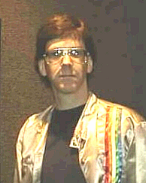
Arcade games? Intellivision games? Atari VCS games? Handheld electronic games? All of the above! To say David Rolfe is a multi-talented programmer is a little like saying the sun is hot. Without a doubt, he's "been there, done that". So sit back and relax as we probe the mind of another industry pioneer…
Q: What college did you attend, and what was your degree in?
David Rolfe: Caltech, BS in Engineering, 1977
Q: What is your work chronology for companies you worked for?
David Rolfe: I was at APh from 1977 through 1982, where I did the Mattel work, except for time away in 1977 and 1979, where I worked for Ted Michon (Technical Magic) to develop Star Fire, Fire One!, and Kreepy Krawlers. I was at Cheshire for the Activision stuff from 1982 to 1984.
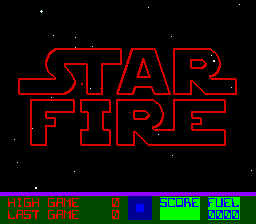 Q: Did you have any programming experience (either personal or professional) before doing Star Fire?
Q: Did you have any programming experience (either personal or professional) before doing Star Fire?
David Rolfe: I did lots of programming as a student at Caltech. Star Fire was the first video game I programmed.
Q: How did you meet Ted Michon, who is credited for Star Fire's graphics?
David Rolfe: Ted was two years ahead of me at school, so he graduated before I did and found his way into this line of work. My first real work for him was in late 1977 after I graduated; that was Star Fire. I was purely a programmer; Ted could program, but his technical orientation was in hardware design. He created the platform for the various games he/we developed. Ted saw that games should have processors and be programmed, but in the early days, this was considered a radical notion. I think they didn’t let him build a processor into the original Night Racer (Ed: which was based off of Reiner Foerst's Nürburgring 1) so it was driven by dedicated hardware. As I recall, later Atari licensed it, and the Atari version did have a processor (Ed: Night Racer is similar to Atari's Night Driver, but not the same).
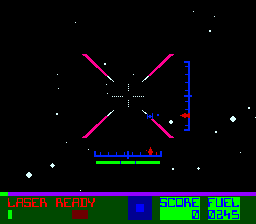
Q: How did you avoid any lawsuit(s) from Lucasfilm over the obvious references to Star Wars with Star Fire?
David Rolfe: Ted thought Star Wars was the very best film ever, so he aspired to create a Star-Wars kind of experience. He figured that, as the game approached production, either the manufacturer would acquire the legal rights, or we’d work with the lawyers to avoid infringing upon copyrighted material. We couldn’t acquire the rights (obviously if we had, it would have been even more Star Wars-like), but I don’t think anybody ever got sued, so I guess it was okay.
Q: What was the reason (or reasons) that Midway passed on Star Fire?
David Rolfe: Midway didn’t like the way it turned out. They simply didn’t get excited by the game play. We worked with them a while to make changes they suggested (speed, targets, whatever), but ultimately they weren’t happy.
Anecdote: Hank Ross, then-president of Midway, suggested that it would help if a witch on a bicycle (like in The Wizard of Oz) would peddle across the screen, and the player could shoot her for points. We had our doubts, but, hey, he was paying, so we put in a witch. When you shot her, the message that flashed up was, “A Witch!”. It didn’t help. When we finally sold the game to Exidy, we changed the witch graphic to the Exidy ship graphic, and the message changed to “Got Us!” (as opposed to the usual “Got Them!” when you hit an enemy craft).
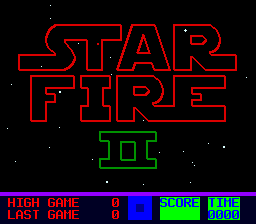 Q: I heard you recently unearthed a copy of Star Fire II. Is this a true sequel that was planned, or an upgrade
for the original game?
Q: I heard you recently unearthed a copy of Star Fire II. Is this a true sequel that was planned, or an upgrade
for the original game?
David Rolfe: Yes, some contact with an arcade collector reminded me that, along with sources, I had an old object file (executable plus symbols), and I had had it at the back of my mind to attempt to extract a ROM image some day. I'd never gotten around to it because I didn't know exactly what I had (maybe nothing new; maybe nothing ROM-able), nor did I know exactly how to extract the pure data, nor did I know what I'd do with it if I did extract it. But I got into the spirit of the thing in talking with a collector, thinking that there were people who would actually ROM the results and/or help me get it running under MAME. My *guess* was what I had was the final Star Fire ("Star Fire II") data, which was not in circulation, so I thought it might interest the fans or people with working game units. For the record, I recall 3 Star Fire ROM versions over its history. The first two versions, which are commonly available with MAME, differ from each other only in that we compressed the data to a greater extent in order to reduce ROM requirements from 11 to 10. But at the end of the run, Exidy figured they could sell another batch of units if we would come up with "Star Fire II". I think they were talking about an export unit. There were to be a few changes, but these were really just refinements - not worthy of the "II". The biggest change I recall, aside from the title screen, was for the high score collection and display. I'm speaking from memory, so I may have gone a bit astray, but that's what I recall. I don't recall for a fact whether Star Fire II units were actually produced; I certainly don't recall ever seeing any Star Fire II's in the field. Anyway, the bottom line is that I extracted the data and then I got in contact with Dave Widel, who prepared an experimental MAME that would accept the new ROM set (there were 12 ROMs), and it worked.
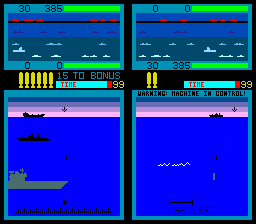
Q: Was Fire One inspired by similar “sub” games like Sea Wolf?
David Rolfe: Ted wanted a greater degree of realism than any previous sub game. So we created the periscope effect, and the radar, and the ability to surface and submerge, and controlled motion, and both defense and offense. And also the dual perspective; that is, the opposing player is looking at the same
field of play you see, but from the other side.
By the way, this interview experience also got me to run Fire One again. Fire One wasn't commercially successful, but actually I like it more than Star Fire. Maybe it was too complicated for people to figure out; it has a lot of features to assimilate in order to get good at it. Or maybe it's simply not a good game. But I'd like to encourage people to take a look at it. I think it was a rich simulation game, and far ahead of its time, if I do say so myself.
Q: Although a game flyer is rumored to exist for Kreepy Krawlers, it’s believed that the game wasn’t released. What can you tell us about that one?
David Rolfe: Kreepy Krawlers was the last arcade game I worked on (1979). It was an attempt to pull something together quickly that could be manufactured cheaply (it was in black-and-white, avoiding the costly color hardware). At the point I left it, my sense was that it had the full game functionality, but it hadn't been refined to the point that it was fit for release. I figured that if Exidy decided to build it, it would require additional work. But my understanding was that Exidy wasn't enthusiastic, and so as far as I knew, it was never manufactured. I'm surprised to find ghostly references to it on the classic lists!
Q: Why did you get out of writing coin-op games?
David Rolfe: As I start to answer this question, I stop myself, sensing my answer is inadequate. All my life, I’ve fumbled furiously to find the best place to focus my professional skills, considering my strengths and weaknesses and temperament, as well as the real-world options that seemed within reach. I had done some back-and-forth jumps between jobs where I did the arcade work and the home game work. To cut to the chase: It seemed like the thing to do at the time.
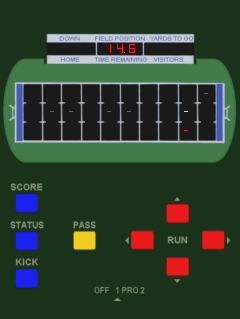 Q: How did the Mattel handheld games come about? I know you did Football II; did you do the original Football?
Q: How did the Mattel handheld games come about? I know you did Football II; did you do the original Football?
David Rolfe: The founders of APh had designed the original handheld Football game for Mattel. That was the beginning of the relationship between APh and Mattel. This was when APh consisted of the two partners, before I was an employee.
Q: You also worked on a pinball game. Do you recall the name of it?
David Rolfe: I don’t recall any name other than Pinball. This one never made it to market, and I didn’t work on any other handhelds after that.
Q: Do you remember when APh first started working on Intellivision?
David Rolfe: As I recall, we first heard of the Intellivision project in December of 1977. General Instruments had been developing the graphics chip set, and some local Mattel people had been designing the hardware (such as the handsets). One of their local people was also trying to develop a suite of games, but he was in over his head and got bogged down. APh was the operation that had saved the day with the handheld Football (this was before my time, but I’d been told that APh was not the first company to try to tackle that project), and so we got called in here. We were rushing because Mattel wanted to show a demo behind closed doors at C.E.S. in early January of 1978. We got that done, and the rest is history. That’s what I recall.
Q: With programming the Intellivision’s Exec program (quite possibly the world’s first gaming OS!), how were the specifics, of what the program’s protocols would be, decided upon – was it an evolving process involving the hardware designers?
David Rolfe: This was a tricky business, because I couldn’t write a game without the OS, and yet I wanted to write a game first so I’d have a clearer picture what services the OS should offer, and I was also strictly limited to 4k for the size of each. My previous work on Star Fire helped me a lot, because I had
developed techniques for controlling generic objects with specifiable attributes that I now adapted to the I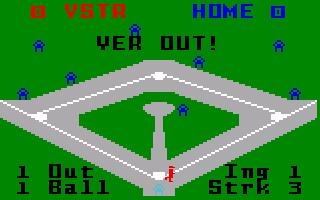 ntellivision environment. In a sense, I created a crude object-oriented programming model, only the “objects” were real screen
objects rather than software concepts. As I recall, I was developing Baseball and the Exec at the same time, clarifying the details and smoothing out this model into a workable form. This was in the early part of 1978; then as summer came, we hired some Caltech students to write games over the summer under my direction, using the programming model I had developed. Once that happened – that is, once I had told others how to proceed – then my flexibility diminished,
because a group of people were starting to depend upon the consistent structure. On the whole, I think it worked out fairly well, in that I didn’t come to horribly regret the resulting OS. Remember that, once it was shipped, we didn’t even have the ability to fix bugs, because all of the games referred to specific ROM addresses scattered throughout the Exec code. So any change at all would have torpedoed the existing game base.
ntellivision environment. In a sense, I created a crude object-oriented programming model, only the “objects” were real screen
objects rather than software concepts. As I recall, I was developing Baseball and the Exec at the same time, clarifying the details and smoothing out this model into a workable form. This was in the early part of 1978; then as summer came, we hired some Caltech students to write games over the summer under my direction, using the programming model I had developed. Once that happened – that is, once I had told others how to proceed – then my flexibility diminished,
because a group of people were starting to depend upon the consistent structure. On the whole, I think it worked out fairly well, in that I didn’t come to horribly regret the resulting OS. Remember that, once it was shipped, we didn’t even have the ability to fix bugs, because all of the games referred to specific ROM addresses scattered throughout the Exec code. So any change at all would have torpedoed the existing game base.
Q: What were some of the demos or experiments you first wrote for the Exec?
David Rolfe: The demo for C.E.S. in January, 1978, simply gave you the ability to run a man around on the screen under control of the handset. We had the original “running man” graphic, with 8 steps of animation, and separate graphics for sideways running and up-and-down running. That was pretty impressive in 1978, when the graphics world consisted of rectangles. And I think there might have been some collision-detection (such as a tackle situation), but I’m not sure. By the way, the pictures came from Mattel; I think the artist was Dave James. A big part of the Intellivision magic was that there were a couple of artists who understood the technical limitations of the environment (such as repeated 8x8 blocks) and could work within those limitations to give us great graphics that we could actually display.
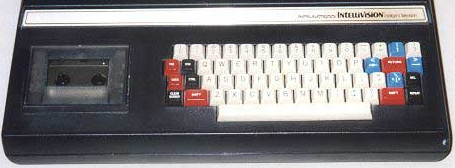
Q: You also did a tremendous amount of work for the Keyboard Component (such as writing the PicSe control program). Were all the release delays due to it being an overly-ambitious project? What were the reason(s)?
David Rolfe: The Keyboard Component was vastly ahead of its time. We did some wonderful work on this, and I’m not just being hyperbolic. For example, we had a cassette to teach the French language. The “lessons” were driven by the recorded voice of Mimi, the French teacher. We had a graphic of a talking female head, and the lips moved in proper synch with the tape (this was very hard to do, because the tape speed was variable; I wrote the program to maintain coordination). She would direct the student to say a phrase; the tape then would record what he said; then she would play back both her proper pronunciation followed by the student attempt. We also had a Jack LaLanne exercise tape, with his voice giving instructions, and a graphic of him illustrating each individual exercise. There was also great music, specially composed for each exercise (I remember one title for a neck roll exercise; the musician had playfully titled the piece “neck-roll-philia”), and rendered in 3-part harmony with lots of effects (for example, we could render glissandos). We would record how far the user could go, so we could chart his progress and recommend a regimen. We also had a stock-charting tape, which could record and analyze the price trends of your stocks. And I recall one of our people talking to Jeane Dixon; I think we were exploring an astrology cassette!
The keyboard unit was briefly test-marketed in Fresno and then dropped. My understanding is the problem was it simply cost too much, and they couldn’t bring the price down.
I wonder if anybody can run any of the above-mentioned software today. I’m sure there are fragments of videotape somewhere; it would be interesting to see or hear it. You understand that we can’t simply emulate the software on a PC like we can for a game, because a cassette consisted of chunks of software, carefully positioned and ordered on the tape.
Q: Any involvement with the Intellivision II or II Exec program?
David Rolfe: I don’t recall making any revisions to the Exec, except maybe some text in the copyright screen for the Sears version, or something like that. I think I was already with Activision at the point when Mattel was contemplating a major new system.
Actually, I just glanced at your Easter egg page, where you say something about Intellivision II refusing to play some of the Coleco games. I had forgotten about this, but it sounds familiar, now that you mention it. I could be wrong here, but I don’t think I made that change to the Exec. I think someone inside Mattel did it. And I think I was very surprised, to find that any tampering had
been made with my code. You see, the Exec couldn’t be substantially changed without breaking a number of games in the field. Otherwise, there were a few changes we’d have liked to make. We had considered this and decided not to. So I would look upon changes with deep suspicion. And indeed, your story indicates a number of unintended consequences. But my memories are vague. So I think that’s what happened, but I wouldn’t stake my life on it. If I
ever found out exactly who did what, I don’t recall it now.
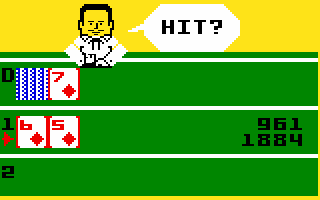
Q: I know you wrote 3 of the first Intellivision games. How many games total were in that initial batch of released titles?
David Rolfe: I think the first game I did was Baseball, followed by Blackjack & Poker. Baseball was a good development game because it stressed the graphics (with background and multiple animated objects); the card game had fluff animation but it was scripted and so not as stressful. Later I wrote
Checkers. Aside from Baseball, our summer hires created several other early games in mid-1978. As I recall, these were Backgammon, Tanks, Football, and Auto Racing.
Blackjack & Poker was included in the box with the console. There was a legal reason for this: the infamous Sanders patent claimed rights to any video game in which one moving object appeared to interact with another moving object. Mattel expected lawsuits. By making sure that the console didn’t ship with an action-oriented game, Mattel figured that the lawsuits would only involve the individual cartridges rather than the console itself. That’s the way I understood it,
anyway.
Q: What inspired you to implement voice in Major League Baseball? Was the Intellivoice module really necessary for any of the voice games?
David Rolfe: This was an odd tale. An APh employee, Hal Finney, was experimenting with the Intellivision sound chip. He wanted to see if he could reproduce vowel sounds – a, e, i, o, u. He struggled with this for awhile, and had it doing something like “eyooowwwww”, which is kind of what it sounds like if you run the vowels together. He called me over in his excitement and asked me what I thought of it. I hadn’t known what he was doing, but I was trying to finish up baseball, so that’s what I was thinking of. So I said, “Hey, you’ve got it saying, ‘You’re out!’” He explained his processes, and then he figured he could alter the sound to really do “you’re out”. And so we used it, displaying the “Yer out” text, because the sound wasn’t all that clear. This was a neat and serendipitous little quirk, but in no way comparable to the voice unit.
Q: Las Vegas Blackjack & Poker has been found with onscreen copyright dates of both 1978 and 1979. Do you know what the reason was for this? Was the program changed or revised in the 1979 version?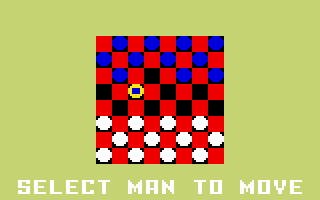
David Rolfe: I don’t recall any revisions, but I may have forgotten. Presumably the ROMs are different.
Q: How does it feel knowing that both Blackjack and Baseball have some of the highest production numbers of any Intellivision title (nearly 2 million Blackjack carts, mostly by virtue of being the system’s pack-in game up until late ’82), and over 1 million MLB carts)?
David Rolfe: Yeah, Blackjack & Poker doesn’t really count, being packaged with the console. Baseball is better, because people had to choose to buy it. I always get a kick out of people running software I’ve written. I don’t enjoy writing software in a vacuum; it’s got to get used!
Q: There are 2 known versions of Checkers. The original version had a bug where it appeared that one of the counters could overflow, and a check was added to prevent it from doing so (in the later version). Also, the "fixed" version has different sound effects. Was there a reason for changing the sounds?
David Rolfe: Hmmm, I don’t recall changing sounds. I do recall that the original Checkers had a bug that caused a look-ahead algorithm to go one step too far and overflow its RAM boundaries, with catastrophic results. I fixed that.
Q: Do you recall what the logo on the box is? For an “official” association of checker players, perhaps?
David Rolfe: Mattel was very big on buying the rights to label as many games as possible with an official affiliation. Off the top of my head, I don’t recall whose logo appears on the checkers box, but I guess it would be consistent that something is there.
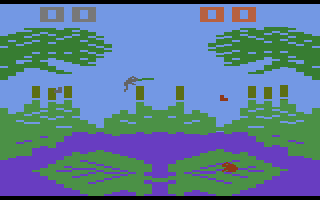 Q: Was doing M Network games (for the Atari VCS) something that was assigned to you, or did you offer to do them?
Q: Was doing M Network games (for the Atari VCS) something that was assigned to you, or did you offer to do them?
David Rolfe: The M Network stuff was a super-rush job, and we were offered a big economic incentive to make it work, so we struggled to quickly find who could do what the fastest. I was obviously the best person for the baseball game, because I had developed the original game. I picked up Frogs & Flies because I could; it was a lot simpler than Baseball; unfortunately, due to greed and pettiness on the part of the boss (long story!), we didn’t collect on the economic incentive part, but other than that, it was a great project.
Q: Super Challenge Baseball was an incredible leap forward over Atari’s initial effort, Home Run. Was it a challenge to try and get as close to your MLB game as possible?
David Rolfe: Absolutely. MLB was the model; Home Run was a joke. I was very pleased how well that worked out. I had to get a bit tricky to make the Atari controller select one of 8 players (we lost the shortstop!), but I managed.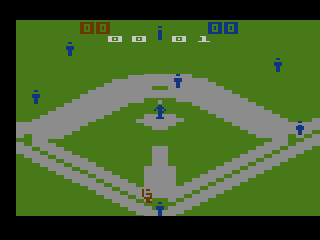
Q: I’ve read the early name for Super Challenge Baseball was Big League Baseball. Is this correct? Do you recall if any of your other games had tentative titles? Did you have any input with naming your games (artwork, manuals, etc.)?
David Rolfe: I didn’t really think about this much, as I had no input here. Baseball was baseball, etc. These were marketing/political questions, and maybe depended upon what license could be acquired.
Q: Your “personal instructions” for Frogs & Flies are hilarious. Can I assume you weren’t too happy to be doing this project?
David Rolfe: This is how I amuse myself. That’s what I like about being an engineer: You can work behind the scenes and be as weird as you like, as long as the product flies straight and narrow when it’s in the spotlight.
| Personal instructions: “Basically, VCS Frogs and Flies is a stupid game directed at stupid kids who come from stupid families which are headed by slothful parents who were too ignorant and cheap to buy the Intellivision Master Component, so they bought the indescribably bad Atari VCS unit instead. Most Atari games are so moronic that, as the Atari commercials delight in pointing out, they can be mastered in a number of minutes by the
family pooch. The VCS unit itself is so worthless that it has been personally denounced by Richard Nixon and hailed by Carl Sagan as "the greatest boon to mankind since the scratch 'n' sniff bicycle seat. The particulars of Frogs and Flies involve the player jumping up in the air to capture and swallow flies with his sticky and extended tongue. This game is recommended by psychologists for young children since it provides excellent educational benefits for a fertile young mind, particularly in the areas of personal hygiene and oral sex.” |
Q: Did you leave APh, in a dispute over revenue for doing the M Network games, to help form Cheshire Engineering (and worked on games for Activision)?
David Rolfe: Yeah. Long story, and not a very pleasant one.
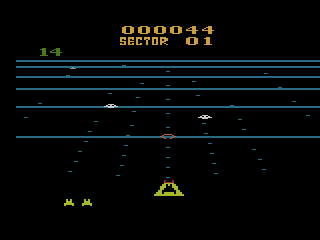
Q: Did you do both the Atari VCS and Intellivision versions of Beamrider?
David Rolfe: Yes. Larry Zwick developed the graphics for VCS Beamrider (which was quite a feat, considering how difficult it is to generate an elaborate VCS display).
Q: The story of how the idea for Beamrider came about is well-known, but in one interview you mentioned that the idea was from a notebook of Tom Loughry’s. Was the concept your idea or his?
David Rolfe: Tom developed the basic concept for Beamrider. I couldn’t have done it without him. I fleshed it out and struggled to nail down the billion details that are part of any game development.
For the record, (Intellivision) Beamrider was an 8K game. My previous games had been 4K. Unlike my previous games, Beamrider didn't use the Exec; since I was no longer working for Mattel, I wasn't allowed to know the "secrets" of the Exec, so I wrote everything from scratch.
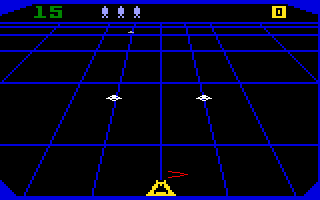 Q: You couldn't use it even though you wrote it? Wouldn't that somehow make
you exempt?
Q: You couldn't use it even though you wrote it? Wouldn't that somehow make
you exempt?
David Rolfe: Yes, I wrote it, but it was still a Mattel trade secret, and it would have been very illegal for me to make use of those particular details. In fact, the only reason I had any legit knowledge of the Intellivision hardware at that point was because Activision had independently reverse-engineered the system, and they provided the specifications. Aside from legal or moral mandates, there was bad blood between us and the guy we used to work for at APh, and we knew we needed to be very careful not to place ourselves in an exposed position, because we had been threatened with legal action if we did any more games at all. So we didn't want to give him any valid basis to stomp us, and neither did Activision.
Q: Was it more difficult to write a game w/o the use of the Exec, or did you find more freedom in how you programmed?
David Rolfe: Actually, working without the Exec wasn't a problem. First of all, we had more space than the early games - 8k instead of 4k - so we could add more baggage. Second, we were trying to create some new effects, so it was helpful to be able to choose a path based upon exactly what we wanted to do, instead of being influenced by the concern that we should choose the path that the Exec made easiest. The structure of the Exec had driven a lot of the mainstream games up to that point, but any structure can be a double-edged sword. So we were given more freedom to transcend.
Q: Is it true that your signature in the Beamrider manuals in fact isn’t yours?
David Rolfe: Yeah. I got Kevin Miller to sign my name. I figured I didn’t need a million copies of my signature floating around the world. Why make it easy to forge my name?
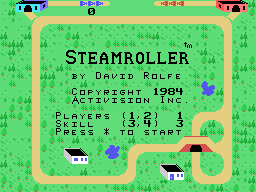
Q: Were there plans to sell Steamroller (for the Colecovision) to another company for release (if so, which one)?
David Rolfe: Steamroller was done at Cheshire under contractual obligation to Activision. It was a grim period in game history, because product simply wasn’t moving. So game development seemed pointless to me, because I sensed that nobody wanted the stuff. The sale closed, but game development at Cheshire petered out after that. There were still some games under development, and I don’t have all the gruesome details in my head, but you get the general picture.
Q: What kind of development system was used at Cheshire?
David Rolfe: We had our own assembler and emulator/debugger. Larry Zwick did a lot of our development software (unfortunately, he died a few years ago of skin cancer).
Q: Do you recall what other games were in development at Cheshire when they shut down the game development group? Or any Intellvision or 2600 games at APh that were never finished or released?
David Rolfe: There were a couple. My Steamroller, of course. Larry Zwick was working on a pinball-type game, Shal Farley was working on a game that involved climbing a tower; Kevin Miller had a flying game in the works. These games had originally been intended for the Intellivision platform but were later switched to Colecovision and finally cancelled. I believe Tom Loughry went on to finish another game with a name like “Star Siege” (for Colecovision?), but it did not get picked up by Activision. My details could be slightly wrong here.
Q: Did you stay at Cheshire after that (the company is still in business – www.cheshireeng.com)? What are you up to these days?
David Rolfe: I left Cheshire after Steamroller. I was frustrated and wanted to get away from games. I jumped into the PC world, where I’ve been ever since. Bottom line is, in everything I’ve done (including games), I consider myself a software toolmaker, and my function is to make the power of the computer accessible to the problem the user wants to solve. These days I write control software for scientific test equipment that measures the properties of thin-film magnetic materials.
Q: Any games that you worked on and never finished, or any ideas that you wanted to implement with any of your released games but couldn’t (due to time or memory restrictions)?
David Rolfe: Nothing comes to mind that hasn’t already been mentioned. We used to joke about doing “adult” games such as strip poker. Then someone came along with Custer’s Revenge, which created a stir but didn’t seem to work out terribly well.
Q: Besides Star Fire, any of your games have Easter eggs or other hidden surprises, or possibly glitches that were never fixed?
David Rolfe: Beamrider for Intellivision had a secret startup code to display some Cheshire Engineering names. This was triggered by holding down (if memory serves) the 6 key on the left keypad and the 8 key on the right keypad when the cartridge was reset. Normally Beamrider would cycle through 4 standard
lines of text in its introduction screen (which plays until the user starts a game). When you press the magic key combination, it adds the extra lines to the display. I worked this kludge into the game with only a minimal addition to the functionality. This was, as always, important, because space was at a premium.
For the most part, I didn’t have enough extra ROM space to add secret features. The games for Mattel tended to be packed to the brim.
I don’t recall any bad glitches in my games that were never fixed. There was the crash bug in Checkers which was fixed. In Super Challenge Baseball, if a run scored during a play that caused a third out, the run was allowed to count, which it shouldn’t have. I knew about that but simply didn’t have the space to fix it. It’s not like it would have been conceptually difficult to fix, but the game was packed.
I'm pleased with how well the Exec
served as an adequate framework for what was to come. But we tend to
agonize over the flaws in our work; it's silly, but it's part of the temperament
that encourages us to do our best. You know what I mean.
In 1978, of course, I had no idea how far this thing was going to go. The
Intellivision was a dubious prototype; a big box full of wires. It limped
along as a project, unclear whether it would ever come together or be sold.
I got the task because I was pretty much the sole full-time resource at the
time. This is the sort of happenstance that makes me wonder about that
"meaning of life" thing. I mean, in retrospect, I get the feeling that the
plans I've made have never gone as expected, but the amazing things that have
happened and the things that have worked out wonderfully; these were all random
chance or acts of God.
So what practical lesson am I supposed to learn from that? That I should
never plan ahead, and just react? No, that can't be right. I guess I
don't know. But regardless of lessons learned or not learned, I'd like to
think there's a greater order to the universe; however this quest for faith must
be balanced against the self-centered arrogance of asserting that the Creator of
the Universe decided He needed me to program the Exec.
Anyway, the factors aligned to put me there, so I did my part. And other people
did their parts, and here we are (for further contemplation of the "who's in
charge here?" question, I would urge all seekers to at some point during their
corporeal sojourns pick up a copy of Tolstoy's "War & Peace" and see if it grabs
you). After a false start (Maude, blah!), I found a translation I liked
(Rosemary Edmonds), and it drew me in. This book captures the characters
in all their strengths and weaknesses and messy complexities, and at the same
time gives an insight into the greater forces that may be at work; the patterns
that people are part of, but that they themselves lack the vantage to perceive.
Amazing stuff.
Q: What are some of your personal favorite games (for any platform)? What are your thoughts on the current state of gaming?
David Rolfe: My best answer to this question is a meandering answer. When I was a kid, all the machines were dumb. Like, for example, a typewriter. I think I was in high school when I first saw a computer console where you would be asked to type in your name and then it would type back, “Hi, Dave”.
That was the most amazing thing ever! I was fascinated by processors which could respond and thus create the appearance of smart machines. When I was working on games, that was the kind of magic I wanted to bring to the world at large. I knew that the game consoles were basically the introduction of computers to the general public. They were part of a process of preparing people to accept and deal with clever machines everywhere. Everything was still mechanical:
phones had rotary switches, as did television tuners, etc. Anyway, after I had done game work for a few years, the task seemed less im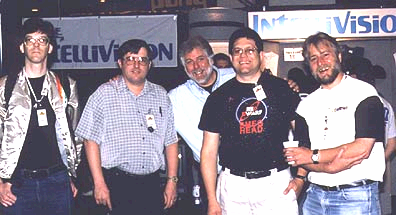 portant, because the essential job was done. Computers had come to the people. But I wasn’t
really a gamer myself. I wasn’t fascinated by the games. The games were fine, but they were just you and a box. The next step of evolution was to break out of that box. The computers were destined to reach out into the world, and to talk with each other and with other users. I got glimpses of this at college, with timeshare systems (where your friends were always online) and the ARPA net. So I don’t really have much to say about my favorite games or the
current state of gaming. I think it was all about the Internet, all along. So quickly we take it for granted, but it’s the most fundamental thing to come along since the automobile. The car gave us freedom of quick individual physical motion; the Internet gave us instant individual freedom of intellectual and social motion. Of course, freedom is a double-edged sword and can get us into a lot of trouble if we’re unworthy (and too many of us are), but I love it
nevertheless. I’m sorry if my answer seems to have strayed from your question, but that’s the connection I make.
portant, because the essential job was done. Computers had come to the people. But I wasn’t
really a gamer myself. I wasn’t fascinated by the games. The games were fine, but they were just you and a box. The next step of evolution was to break out of that box. The computers were destined to reach out into the world, and to talk with each other and with other users. I got glimpses of this at college, with timeshare systems (where your friends were always online) and the ARPA net. So I don’t really have much to say about my favorite games or the
current state of gaming. I think it was all about the Internet, all along. So quickly we take it for granted, but it’s the most fundamental thing to come along since the automobile. The car gave us freedom of quick individual physical motion; the Internet gave us instant individual freedom of intellectual and social motion. Of course, freedom is a double-edged sword and can get us into a lot of trouble if we’re unworthy (and too many of us are), but I love it
nevertheless. I’m sorry if my answer seems to have strayed from your question, but that’s the connection I make.
Q: Any stories or memorable moments from your early days working in the industry?
David Rolfe:
This was in the early 80's when Intellivision had been on the market a couple of
years, and the original team was still at APh. I think there may have been
regional variants of the show, but my recollection of the name is "Say POW", and
it was broadcast by a local TV station, KTTV, at what I recall to be a late
time: 10:00 or 10:30 on Sunday night. The KTTV studios were on Sunset
Blvd. just west of the Hollywood freeway. The show didn't have a very long
run.
The nature of the game require a live show. No tape, no delays, because
the caller had to see the live image. They invited a studio audience, so
one night four of us tech boys piled in a car to see how the sausage is made.
It was a small studio, and we were practically the only people in the audience.
So the cameras never panned the audience, and if they used any crowd reactions,
it would have been canned sound. I think it was a version of Hal Finney's
"Star Strike" that was used for games, and I suppose there were others. I
hadn't done any mod work to render games pow-accessible, so I hadn't been
concerned about the gory details.
Nothing noteworthy happened during our visit, but a couple weeks later Hal
Finney (who hadn't been with us) went to the show and came back with an odd
anecdote. I had no independent verification that this actually happened,
but Hal was not a teller of tall tales, so I assume it's real.
As I said, this show was necessarily live, and the emcee had a phone for the
purpose of connecting to the contestant. Apparently that phone had a
direct-dial number, rather than just being a switchboard extension. And
apparently some joker knew that number. So, as Hal reported it, as the
emcee was chatting with the contestant as the game started, a joker somewhere in
the world was picking up a phone and calling the phone company operator and
telling that operator there was an emergency and it was necessary to immediately
cut in on such-and-such a line. I'd never thought about this, but I guess
it makes sense that operators would do this in an emergency situation. So
the POW game would sputter as an operator came on the line and announced an
emergency, and then cut in with the joker who would start to curse. The
emcee would hang up and try to restart, and of course another "emergency" would
happen. The emcee was struggling to tell the operator that there was no
emergency and not to put the joker on the line, but it was an uphill battle.
That's what Hal told us. If it's not true, then it should be.
Q: Have you kept anything from your time in the industry back then?
David Rolfe: I have Beamrider source on disk and hard copy source (old fanfold line printer format) for other stuff I worked on, plus doc. I don't know what its legal status is, or what the Intellivision Productions position is with respect to putting it out (and I'd like to hear the IP official position on the matter!). I can tell you that the old source might be historically interesting, but I doubt it would be of any technical use to anyone. Maybe that's my prejudice speaking, but I generally regard looking at other people's code as an exercise in frustration. That's especially true of Baseball, which was a learning experience, and the code is a blight on humanity, except for the minor virtue that it worked.
When Worm Whomper was released, I thought the artwork was cool, so I grabbed one of the promotional posters (24" x 18") and framed it. Still have this hanging in my kitchen. For all I know, it's the only one left.
Q: Final thoughts on looking back at your past work?
David Rolfe: I've covered a lot of turf in classic game development, from arcade games to handhelds to 2600 and Colecovision, but the thing that is most "mine" is Intellivision. I was the first Intellivision programmer, and I developed the "Exec" control program and software protocols and tools for game creation. Oh, I also did some similar stuff for the ill-fated keyboard unit, but that doesn't jump to mind so quickly, since it never made it beyond test market (due to cost). But we did some really great stuff there.
Mattel's M Network commercials for Atari VCS/2600 Super Challenge Baseball:
TV Powww! and WPIX Channel 11 TV Pixxx game show footage and commercial featuring Channel F and Intellivision games:
Check out David’s personal website at: http://home.earthlink.net/~davidrolfe/dbrbio1.htm
| GAME | SYSTEM | COMPANY | STATUS |
| Star Fire | arcade | Exidy | released |
| Star Fire II | arcade | Exidy | unreleased |
| Fire One! | arcade | Exidy | released |
| Kreepy Krawlers | arcade | Exidy | not completed |
| Football II | handheld | Mattel - APh | released |
| "pinball" | handheld | Mattel - APh | unreleased |
| Intellivision Exec OS | Intellivision | Mattel - APh | released |
| Major League Baseball | Intellivision | Mattel - APh | released |
| Las Vegas Poker & Blackjack | Intellivision | Mattel - APh | released |
| Checkers (aka Draughts) | Intellivision | Mattel - APh | released |
| PicSe Keyboard Comp OS | Intellivision | Mattel - APh | released |
| Super Challenge Baseball | Atari VCS/2600 | M Network/Mattel - APh | released |
| Frogs & Flies | Atari VCS/2600 | M Network/Mattel - APh | released |
| Beamrider | Atari VCS/2600 | Activision | released |
| Beamrider | Intellivision | Activision | released |
| Steamroller | Colecovision | Activision - Cheshire Eng. | unreleased |